
VOLKSWAGEN Passat
Generations Timeline, Specs and Pictures
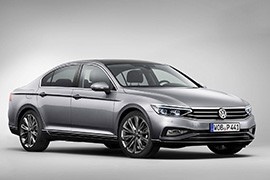
With no less than 30 million Passat models having spawned from Wolfsburg and over 7 generations of the nameplate creating its own legen, the eighth iteration of the model in mid-cycle facelift guise was unveiled in 2019.
Thanks to a cornucopia of technology added to the model, most of the new features having trickled down from some of the more premium car brands under the Volkswagen Group umbrella, the eighth Passat is now more advanced than ever.
Most of the refresh is found inside, where thanks to new hardware and software, the new Digital Cockpit has been massively improved compared to the previous Active Info Display. With much enhanced graphics and improved features, the system now offers three various display configurations can be customized using the redesigned multifunction steering wheel. The exterior is almost identical to its predecessor, although newly shaped headlights and redesigned front and rear bumpers give it a slightly more dynamic look.
All gasoline engines now feature particulate filters as standard, while on the diesel front there is a new 2.- TDI Evo engine choice. With an output of 150 horsepower, the powerplants emits 10 g/100 km less CO2 compared to its predecessor. The gasoline engine lineup has been completed with three new engines with 150 horsepower, 190 horsepower and 272 horsepower, respectively.
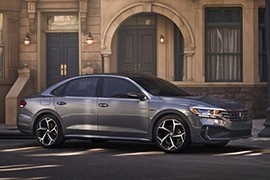
The Volkswagen Passat (US version) was first introduced in 1992 and today is now one of the most popular cars available.
The 2020 Volkswagen Passat comes with a 2.0-liter engine that develops 174 HP and 207 lb-ft of torque, and 6-speed automatic Tiptronic gearbox. The power is taken to the front wheels via the 6-speed automatic Tiptronic transmission.
At the exterior, Passat retains the main characteristics of its previous model, but completely restyling it, with a dynamic coupe-like roofline, thrilling “tornado” line, and aggressive grille, giving the latest Volkswagen Passat a bold stance.
Inside we find a new design and upgraded technology with a spacious cabin. The cockpit incorporates air vents that flow across the dash in a design that reminds of premium models. Furthermore, new colors and premium materials are added to give the interior a slick look.
Volkswagen continues to offer comfort to both drivers and passengers through the following available features: heated front and rear seats, power driver’s seat with memory, dual-zone Climatronic automatic climate control, heated side mirrors with memory, adaptive front-lighting system, auto-dimming rearview mirror, remote start, rain-sensing wipers, keyless access, push-button start, voice control, easy-open trunk, and standard Volkswagen car-net app-connect technology, which incorporates compatible smartphones with Apple CarPlay, Android Auto and MirrorLink.
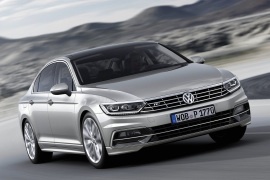
The 2015 Volkswagen Passat debuted with a new design that combines stylish clarity with a high level of impressive power, features that merge both on the exterior and interior.
The exclusive image of the new Passat was achieved in part by a wide variety of extremely precisely drawn edges and creases which develop individual light-reflecting surfaces. The radiator grille is designed to be significantly larger than the headlights. In all three equipment versions (Trendline, Comfortline, Highline) it is upgraded by four chrome bars. On the sides, these bars bend inward towards the headlights in a trapezoid shape. The lowermost chrome bar of the grille is continued into the headlights. Above the grille and the headlights there is another chrome accent which extends across the entire width of the front end, and it is continued laterally in the character line (from “Highline”). Volkswagen developed an entirely new lighting design for the eighth-generation Passat. The car is being offered with halogen and LED headlights. In particular, the LED headlights that are offered in two versions create an unmistakable look. Inside, the designers placed special value on a driver-oriented design and a very spacious feeling of the front interior area. Therefore, starting from the seating position of the driver, the dashboard builds upwards in the space to the two sides of the instruments, inclined slightly towards the windscreen. This creates a spacious feeling as well as an ideal ergonomic landscape.

Volkswagen did an excellent job when it decided to build an American-special Passat for the 2012 model year, resulting in a lower price than on its predecessor.
The German carmaker tried to get a bigger market share in the U.S. mid-size sedan segment with the Passat. For that, it opened a new factory in Chattanooga, Tennessee. Another major decision was to make a different vehicle than its European sibling. Thus, it resulted in the U.S.-spec Passat, which shared only the nameplate and the badge with the German-made mid-size cousin.
Once it crossed the Atlantic, the Passat became longer, wider, taller, and, most importantly, cheaper. It was around 30% less expensive than its predecessor. Its design resembled its smaller sibling, the Jetta. The three-slat grille with chromed accents and the broad lower air-intake flanked by fog lights with angular shapes confirmed it as a member of the Volkswagen stable. The angular-shaped taillights crossed the rear quarter fenders onto the trunk lid at the back, thus creating a classy look.
Thanks to the longer wheelbase than its predecessor, the U.S. Passat provided a more extensive interior for the rear passengers. At the front, the bucket seats offered good side support for both occupants. On the tilted center stack, the carmaker installed a touch-screen infotainment system. The instrument cluster was typical Volkswagen with two large dials for the speedometer and tachometer, plus a TFT display between them.
Under the skin, the Passat received a revised suspension with McPherson type at the front and a four-link independent rear axle. Strangely, the carmaker didn’t make the Passat with an all-wheel-drive system, even though it could. Under the hood, Volkswagen offered a choice of three engines: a 2.5-liter inline-five base model, a 3.6-liter V-6, and a 2.0-liter TDI unit. Later on, the carmaker added a 1.8-liter turbocharged version.
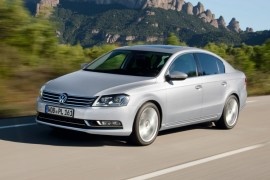
Although it features the B7 designation, the new Passat is actually a facelift of the B6 Passat.
Heavily modified by Klaus Bischoff and Walter de Silva and presented at the Paris Motor Show in September 2010, the car features a totally reworked exterior, with the Scirocco-like grille and headlights being some of the elements that strike the most. The North American version of the facelifted Passat, known as the New Mid Sedan (NMS) until the 2011 NAIAS, will be marketed as a new generation model (MY2012). The two cars feature different specifications however, despite sharing the same platform.

Based on the well-known Volkswagen Passat, the CC version was the 4-door coupe version for the German car-maker.
It was launched in 2008 at the North American International Auto Show.
The CC initials stood for Comfort Coupe and it was the Volkswagen answer for a market that demanded sportier sedans and for customers who didn’t enjoy the coupe versions. Not to mention that Volkswagen didn’t have any mid-size coupe in its lineup.
The design was a daring move made by the, otherwise traditional, Volkswagen brand. A low-profile roof, with very raked A-pillars and narrow front end, would suggest a sports car. The frameless windows were also new for a 4-door Volkswagen. The redesigned front and rear headlights made a clear statement of distancing from the regular Passat.
The interior was designed for four adults, with a sportier design for the front seats and a profiled rear bench for two passengers. The low roof design limited the headroom for the rear occupants. The dashboard was straight, with horizontal lines to amplify the width appearance. The instrument cluster featured carried-over analog dials from the regular Passat.
The Passat CC was offered with a choice of gasoline and diesel engines, with manual or automatic transmission. For specific markets, it was also offered with all-wheel-drive systems, with a Haldex center differential.
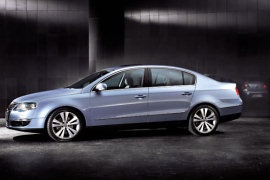
The first Passat generation was launched back in 1973 and it was designed by the famous Giorgetto Giugiaro.
In 2005, the Passat was already at its 6-th generation at it was revealed at the Geneva Motor Show in March.
While the large sedan wasn’t exactly included in the upmarket class, It would differentiate a lots from the mainstream ones. The Passat was a good rival to a lower-end BMW 3-Series or the Audi A4.
The Passat was capable and comfortable on long journeys, with a great suspension setup. The sportier models traded comfort for better handling and were equipped with a lowered suspension and larger wheels.
The most appreciated engines on the Passat were the 1.9-liter with 138 hp and the 2.0-liter with producing 168 hp.
Inside the cabin, the users had an airy feeling due to the great finishes. Roomy in the front, the driving position was very comfortable and the steering could be adjusted to suit every driver.
The storage room inside the cabin was great, with deep pockets into the door panels. The lack of the traditional handbrake contributed to the airy feeling, VW replacing it with an electric version.
The Passat was available with four trim levels: Trendline, Comfortline, Sportline and Highline.
The Passat scored 5 stars at the crash-test results in the Euro-NCAP, having 6 airbags and ESP.

The 2000 version of the Passat fourth-generation brought several upgrades that made the car more appealing to the market and improved Volkswagen’s image.
Also known as the B5.5, the 2000 Passat received a few updates. Even though it was just a regular family vehicle, it could serve as a middle-management company car with the right configuration. Moreover, the base versions were some of the best mid-size rental sedans available on the market.
At the front, the small rectangular headlights from the 1997 model were gone. Volkswagen installed reshaped headlamps and turn signals. The carmaker adorned the grille’s horizontal slats with chromed lines to make the car look more upmarket. Following the same idea of a higher quality product, it replaced the black rubber strips with color-bodied ones. A new set of taillights with butterfly-shaped reversing lights lenses made a clear difference in the rear.
Volkswagen improved the 2000 Passat interior by adding new climate control buttons on the center stack. Depending on the trim level and the options, the carmaker included better infotainment systems on the offer, with satellite navigation. For the instrument panel, the German carmaker added shiny silver rings around the dials and gauges. Thanks to its 2.7 m (106.4”) wheelbase, it offered decent room for rear passengers, although the transmission tunnel affected the legroom for the middle bench occupant.
Volkswagen’s engine choices played a significant role in Passat’s sales. The carmaker offered it with an extensive power range from a fuel-efficient 1.9-liter TDI unit that provided 100 hp up to a 4.0-liter W-8 gasoline engine with 275 hp. It was available with front or all-wheel-drive, with manual or automatic (Tiptronic) transmissions.

The fifth generation of Volkswagen Passat was officially unveiled in 1996 when the German carmaker Volkswagen rolled out a new sedan version of the popular model.
Although it was presented to the European public in 1996, it only arrived in North America in 1998. What’s interesting is that the car is based on the same platform as Audi A4, being also equipped with a front-wheel drive system, just like the Audi model. The car received a ocuple of awards until 2000 when it got facelifted, including the “Best Family Car” award of Auto Express New Car Honours in 1999.

Volkswagen introduced the third Passat generation in 1988 on a new platform and followed a new design concept that affected its successors.
In 1993, the carmaker introduced a heavily facelifted version of its mid-size competitor. Ford put up a big fight with the 1993 Mondeo, and Volkswagen had to upgrade its model. Instead of calling the ‘93 Passat a facelift, the carmaker said it was the Passat B4. But it was the same platform, with the same greenhouse and roof. It replaced the rest of the body panels, though.
At the front, Volkswagen’s designers created a new front fascia with a slatted grille and elongated, horizontal headlights. Unlike the second generation, from the Passat B3/B4, the carmaker offered it only as a three-box sedan or as a station wagon, dropping the hatchback version. Its body-colored bumpers with a black rubber stripe running along the body were a shy step forward over its predecessor.
Inside, the comfortable interior offered a revised interior. The center stack was tilted towards the driver and provided easy-to-access controls and commands. Depending on the trim level and engine version, the Passat featured high-bolstered front seats or plain bucket seats at the front. Volkswagen installed a bench for two in the back, with an option for a center armrest between the occupants. The bench was wide enough for three, but there was no headrest for a middle passenger.
Under the hood, the Passat offered a choice of eight engines, either gasoline or diesel. Volkswagen brought only a few of them on the U.S. market: a turbo-diesel and a 2.8-liter V-6. The former was available exclusively with a five-speed manual, while the latter offered an option for a four-speed automatic.

The third generation of Volkswagen Passat was officially introduced in 1988 when the German car manufacturer rolled out a refreshed version of the model.
Although the Europeans got the new Passat in 1988, the car arrived in North America in 1990 while the South American market received it in 1995. Even if it was based on the B3 platform, just like Volkswagen Corrado, the car shared a lot of parts with the A platform vehicles, most of them Golf models manufactured in the previous years. If its predecessor used different names around the world, the third generation was only marketed as Passat in all countries, including North America.

Volkswagen introduced the second generation of the Passat in 1981, and it showed a clear upgrade over the Golf lineup and a closer approach to the mid-size segment.
While its predecessor was no match for Fiat, Renault, or Citroen, starting with the second generation, it closed the gap with its competitors and, by the end of its career, it managed to overtake them. The German carmaker was riding the high waves thanks to its modern front-wheel-drive concept, while other brands were still stuck with the old-school, rear-wheel-drive sedans. Moreover, it was available for the first time with an all-wheel-drive configuration, named Syncro.
Its angular lines, the big rectangular headlights, and the plastic bumper were a fresh look on the market. The three-box sedan version was not the most popular on the market, but it was considered an excellent middle-management vehicle thanks to its roomy interior. Soon, it became popular for families as well. Volkswagen installed two large dials on the dashboard for the speedometer and tachometer in the angular instrument cluster and two smaller gauges for fuel and coolant temperatures. There was an area with ten lights for turn-signals, hazard, oil-pressure, parking brakes, and a few other important warning lights in the middle.
Volkswagen offered the Passat a wide choice of engines, both diesel, and gasoline. Its long-range autonomy, of over 1000 km (623 miles), made it one of the most cost-effective cars on the market. Its reliability and low running costs increased over the years.























































